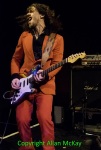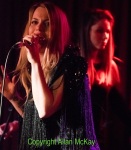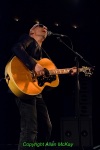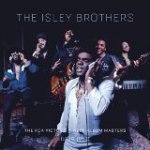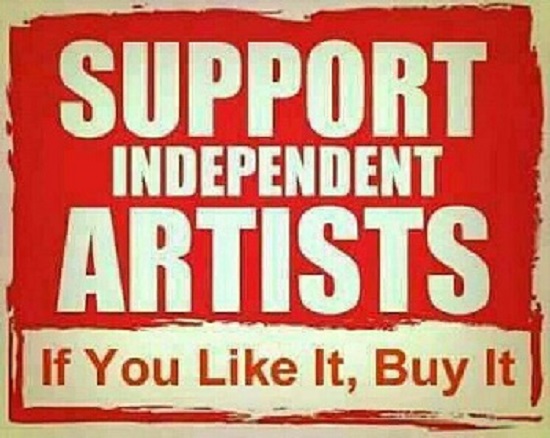
The Guardian published an article a couple of weeks ago by Tim Burgess of The Charlatans about the state of the music business in the light of Brexit, streaming and downloads. It’s an interesting read as far as it goes and it set the cogs whirring about why we got here, where we go next and will it be better or worse, or just different.
In my lifetime, the music business has been turned upside down. In the seventies, bands went out on tour to build up a following and to promote singles and albums, which is where the real money was. If you’ve survived this long and remember all this, bear with me, it’s worth getting some historical context. No internet, no mobile phones, only three TV channels and (until October 1973) no commercial radio. So you were left with the pirates like Caroline and the erratic reception of overseas stations like Luxembourg to let you know about new music. And the music press…
Every week I bought the NME, Melody Maker and Sounds and my paper round meant I could sneak a look at Blues & Soul and Disc/Disc and Music Echo as well. By 1973, with a bar job and a Saturday job with an entertainment agent booking acts for local pubs and clubs, I had a few bob to spend on some of the music I was reading about. Add the cost of my print habit to the cost of buying an album (about five percent of the average weekly wage in the mid-seventies) and being into music was a real financial commitment (even if you took the risk of doing a few temporary swaps with your mates to dip into their choices).
Buying music in the seventies wasn’t just an investment in listening to a piece of music. You exchanged your hard-earned (cash of course) for something physical that you carried home in a bag before lowering it on to the turntable, gently caressing the vinyl with the stylus and waiting for a glorious noise to erupt from the speakers. But let’s just rewind that a few minutes. If you bought an album and you were taking public transport home, you had the chance to look at the album artwork as well. A good album sleeve was so much more than a bit of on-shelf advertising; a twelve-inch square format created opportunities for quality photography and graphic design to enhance the musical content of the package. When it worked, it was an extra visual dimension to a piece of aural art:
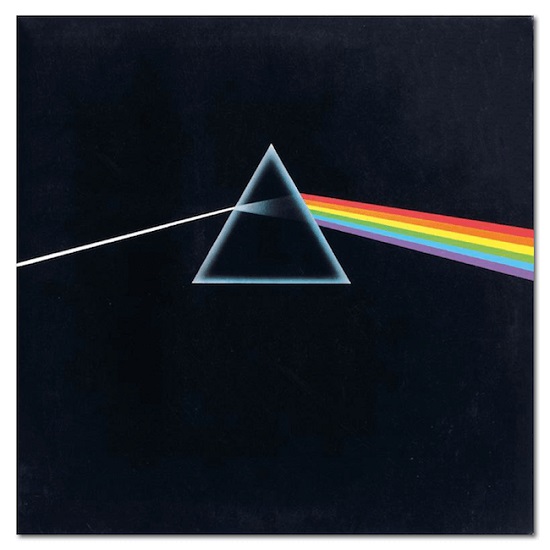
When it didn’t, it looked a lot like this (which proves that you can’t get it right all the time):
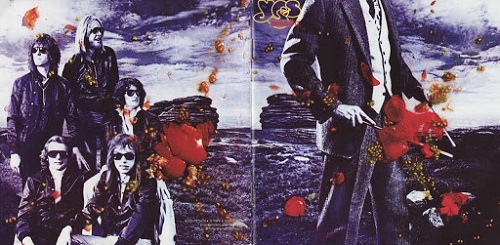
The gatefold sleeve doubled up the visual real estate (exploited perfectly on Thin Lizzy’s “Live and Dangerous” double album with a shedload of Chalkie Davies pics all over the outer and inner sleeves of the album):
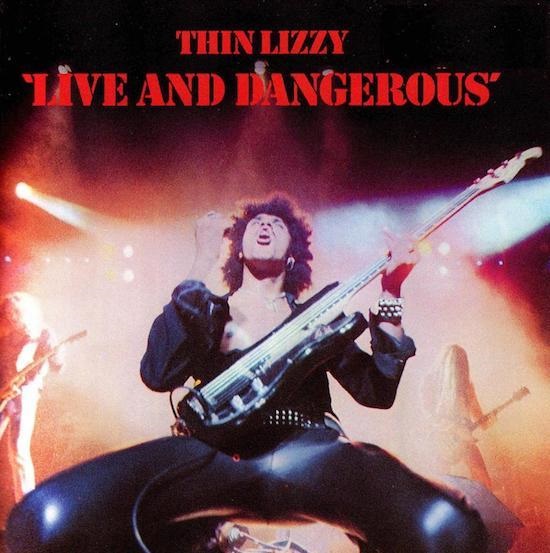
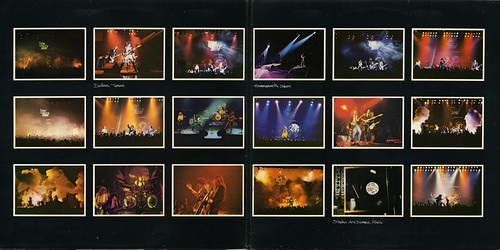
Designers started to exploit die-cut sleeves and all sorts of interesting innovations; PiL’s “Metal Box” looked really clever, but only if you hadn’t seen The Small Faces’ “Nut Gone Flake” packaging twelve years earlier.
The visuals were only part of the album experience; you could get a lot of text on a sleeve, particularly if you had a printed inner sleeve or three as well. There was all the obvious geek stuff; musicians involved, instruments played (or not played if you were Queen) and lyric sheets, but some bands made a real effort; UB40’s cover for the first album “Signing Off” in 1980 was a copy of the unemployment benefit attendance card, they’d been filling in before they broke through. Ten years later, Squeeze released a live album with a boxing concept, “A Round and A Bout” with a little bonus – they listed every gig they’d done between 1974 and 1990 on an insert with the album. Thanks guys, you’ve no idea how useful that’s been to me over the years. Seriously.
I’m sure you get the message by now. During the first vinyl era, the experience was about much more than just listening to the music. You could carry an album around at school as a sign of your taste and discernment and to impress the other gender (I pitied the guys who carried Groundhogs and Genesis albums, but that’s Darwinism for you). It was a bit like creating a mixtape a few years later and a playlist many years later. Or drinking bottled designer lager in the eighties. If you were a fan of music in the seventies or eighties you were committed and attached to it; it had a financial and emotional value. And it had a longer lifespan; since the mid-nineties, the norm is for singles and albums to achieve their highest chart position in the first week of release, but fifty years ago the climb to the top of the charts could take weeks (and probably a few bulk purchases in chart return shops to help it along).
This isn’t a dewy-eyed, rose-tinted trip down memory lane. The seventies and eighties weren’t perfect; the music business was still a business, but it was one where labels invested in bands with a view to development over several years. A moderately successful band writing their own material could make a living for a few years with royalties on sales, radio, juke box and club plays and independent labels were few and far between. Things are a bit more polarised these days; the business only supports guaranteed winners and everyone else has to do their own thing. Time for a bit of a polemic: the technology that enabled the digital revolution degraded our experience of music. Listening to compressed audio on inadequate playback systems is the norm for most people now, despite the vinyl comeback, and the majority of listeners don’t pay any attention to artwork, credits or sleeve notes. We’ve walked blindfold into accepting a gradual erosion of the musical experience in the name of progress and fashion. We also have at least one generation that doesn’t believe in physical musical formats and certainly doesn’t believe in paying for them.
Fortunately the same digital technology that devalued music by making no-degradation copying possible, then compression, along with affordable storage and massive improvements in internet bandwidth, have enabled affordable home recording. Technological improvements cut both ways and musicians are a resourceful bunch; if you can’t get a deal with a major label, what have you lost? You don’t need access to a studio; you can set up at home. You don’t need access to a major label’s mastering and pressing facilities; you can find any number of those online. You don’t need a distribution network; you can load your music up to download and streaming services and make peanuts, or you can sell CDs and albums on your website by mail order and alongside other merchandise at your gigs.
In normal times, this isn’t a bad business model; you might be able to stay afloat if you have another job, have good merchandise to sell on tour, or both. And along comes lockdown; no gigs and no pop-up shop opportunities. I wish I could honestly say that I recommended live streams, but it’s not for me; I really miss the eye contact and (selfishly) I miss the opportunity to take pictures at gigs. If it works for you, that’s great; enjoy it and make a contribution; I’ll be waiting for the moment when live music re-emerges after this terrible disease is brought under control.
Me, I’ll continue to avoid the mainstream by buying (in order of preference) vinyl or CDs directly from artists’ websites, from independent record shops and at gigs. Two people I know have opened vinyl shops in the last few years and both are succeeding despite the current trading situation; long may they continue.
And that resourcefulness and creativity that musicians always demonstrate wasn’t going to be stifled by any number of lockdowns; no way. All of those skills developed and equipment bought to set up home studios have been subtly repurposed to enable musicians to collaborate by sharing audio and video files online. I don’t know any musicians who see this as an ideal situation, but, like solitaire, it’s the only game in town. After nearly a year and millions of audio files bouncing around the internet, albums that were in progress have been completed remotely and albums have been conceived, gestated and born. It doesn’t matter how difficult you make life for musicians (or artists generally), they will always find an outlet.
Whenever we reach the new normal, whatever that may be, spend your money in a way that benefits the people making the music you love. Buy physical copies of music either directly from bands or from independent record stores – there are loads of them. Most importantly, get yourself out to as many gigs as possible. I’ll see you at the front.
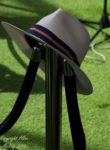 This started the way the best features do, as a conversation in the pub. We’ll let Allan take it from there.
This started the way the best features do, as a conversation in the pub. We’ll let Allan take it from there.
It’s one of the oldest tricks in the pop music book; if the song’s on its last legs and you still need another thirty seconds or so to get you up to the optimal time for radio play, then you deploy one the producer’s most potent tactical weapons – the trucker’s gear change. In its most basic form, the whole arrangement shifts up a tone or a semitone, to grab back your attention before the chorus repeats and fades. Usually, it just happens once, but that depends on how desperate you are (or how weak the song is). You might even get some clever stuff going on to get from one key to the next; when that happens, you get all classical and call it a modulation. What do they sound like? Let’s start with an absolute clunker.
“I Will Always Love You” – Whitney Houston
Considering the quality of the musicians available to producer David Foster, this TGC is bone-jarringly unsubtle; there’s no attempt to pretty it up by repeating a riff in the new key or moving through a few passing chords. Oh no; old key/bang/new key – we’re done. As if that’s not enough, there’s a whole bar of almost complete silence before the melody crashes back in again, maybe David Foster thought that the average listener couldn’t remember which key the song was in after 4 beats. Who knows; anyway it’s a crash/bang/wallop of the highest order and you can hear the teeth grinding off the flywheel:
“Love on Top” – Beyonce
OK, we’re now well and truly in the era of digital recording and production and it’s much easier and quicker to manipulate sounds. You can do a TGC with a mouse-click. If it’s so easy to do, why not do loads of them – one is good, two must be better. Beyonce co-produced this with Shea Taylor, so she’s sharing the blame here. In the last ninety seconds of the radio edit there are four, yes four upward key shifts as the chorus is repeated. It makes you wonder what it would be like if the key shift just kept repeating. As it happens, someone thought of that. Here it is with fourteen upward shifts:
“The Snake” – Al Wilson
Ah, the old Northern Soul classic. Fans will remember that one of the UK pressings of this song had a cover of the John Fogerty classic “Lodi” on the b-side. That’s not relevant, just me showing off. Sometimes you can get away with a few stick shifts if you’re building up to the climax of the song and that’s what happens here. At the end of the second verse, there’s a bass riff which is then repeated a tone higher and you’re in a different key. It’s not just a chorus repeated in exactly the same way but higher, it’s part of the process of moving the story along. And the same device is repeated at the end of the third chorus into the final verse as the song reaches its dramatic finale. Maybe I’m biased, but I think this is part of the arrangement of the song and that keeps it out of Room 101:
“Heat Treatment” – Graham Parker & the Rumour
You might think that any key change part way through a song would be agreed with the writer; it ain’t necessarily so. This was the title song of GP and the Rumour’s second album “Heat Treatment”, released in 1976, the same year as his debut “Howlin’ Wind” (two albums in a year and incessant gigs; musicians grafted in those days). Partway through the song, there’s a modulation; it’s quite musical – a two-bar horn section phrase takes the song up a tone. It’s not lumpy but it does the job fairly quickly. The problem is that it’s not part of generating extra excitement, just the opposite. It takes the song into a bass riff breakdown and the groove has to be built up again from scratch. Graham Parker made his feelings about it known when the album was remastered for CD; his sleeve notes refer to it as ‘that abusive key change’. Fair enough.
“Up the Junction” – Squeeze
This was the title track from the second Squeeze album, with a tip of the hat to Nell Dunn who wrote the novella of the same name. Glenn Tilbrook and Chris Difford were just beginning to realise their potential as songwriters and Jools Holland was still their keyboard player. This is a key change that is about as far from a trucker’s gear change as you can get. It’s a modulation that reflects a downbeat turn in the lyrics through a ten-bar bridge using minor chords before dropping a whole tone for a more upbeat verse and then, paradoxically, going back up by a whole tone for the downbeat final verse. Difford and Tilbrook characteristically messing with the conventions. Bits of “Up the Junction” trivia? There are no choruses and the title of the song doesn’t appear in the lyric until the last three words:
This is an opportunity that doesn’t come along too often these days – an interview with one of my favourite singers and someone who happens to front one of the best bands I’ve ever seen; a bunch of superb individuals who make a formidable team. Southside Johnny and the Asbury Jukes were on a lightning tour of Europe that included a night at Shepherd’s Bush Empire. Too good to miss, really, so I took a little trip out to Wild West London. Here’s how it went…
Allan
It’s great to see you again, what are you up to these days?
Southside
Well, we have a lot of work this year. I mentioned the word retirement and they immediately booked a thousand gigs. We’re trying to write another Jukes album but it’s been going slowly, so really it’s just been touring and trying to write the album and that’s about it. There’s not much else going on.
Allan
On this tour you had a free day in London yesterday. Did you manage to have a look around?
Southside
I walked all round Shepherd’s Bush and around the mall and I wanted to go to the British Museum but I didn’t get it together to do that, but this is a great walking area. I like this place; it’s a little funky in some areas but that’s good for me. I just love walking around London, all the different areas. It still feels like I’m somewhere other New Jersey. Even after all these years and all these times, I still feel glad to be here.
Allan
I’ve lived here fifteen years now and the city’s changed so much in that time.
Southside
It’s impossibly expensive to rent here. Occasionally I think, maybe I’ll go over there for a while, but you’ve got all the Russians and Saudi Arabians that are buying up all the properties. There are people who have lived here for a long time and they’re all right, but if you’re trying to buy a house, you’re out of luck.
Allan
You’ve done Wales and Scotland on this tour as well.
Southside
Yes, we played Cardiff and we played Glasgow. I always like playing Glasgow because the audiences are down-home, very New Jersey, if you know what I mean. They’re very enthusiastic and it matters to them. There’s no pretence about loving the music, it’s just really honest ‘get out and have a good time’ people.
Allan
I think South Wales is a lot like that as well.
Southside
We’ve played a few places in Wales, but not enough for me to really know it. I’ve played a lot of places in Scotland many, many times and I’ve got to know a number of people up there and they’re very authentic people. I really like that.
Allan
I think Jukes fans are like that generally.
Southside
That’s true. We play New York and people drop in to slum it with The Jukes and I don’t really care for that kind of thing. Our audience is like us; there’s no pretension about it.
Allan
And at Holmfirth, you actually had to add a second show this year.
Southside
Yep, Holmfirth is one of our favourite places to play. When we first played there, we got lost. We were driving through fields; the GPS on the bus was completely screwed up and we ended up going through a farmer’s field and thinking ‘Where the hell are we?’
Then we got there and it’s a small town, very picturesque and I thought ‘This is going to be terrible’ and it was great.
The people were just so over-the-top and the place sounded good and there was a snooker table in the dressing room. It was just one of our really fantastic nights and we had a great show, so we always look forward to coming back because they’re always good shows, so everybody’s excited about it.
Allan
And I think this year’s the twenty-first of the venue re-opening as a cinema and music venue, so they may be commemorating that.
Southside
Twenty-one years, huh? I wonder how many times have we’ve played there?
Allan
I saw you there in 2010, I think.
Southside
I think that’s when we started playing it, maybe a little earlier.
Allan
The last time I was in Holmfirth was in October last year to see Graham Parker with his new band The Goldtops, featuring some of the horn players from The Rumour and it felt like a throwback to that period in the late seventies when there was so much great music, and it was strange to see that Steve Gibbons, also from that era, had been added to tonight’s bill.
Southside
(Laughs) I didn’t know that. I just saw now that he was on the bill – that’s great.
Allan
And seeing Graham Parker made me think about the legendary tour that you did together in 1977.
Southside
That was great. What fun that was. Both bands were in the same bus; a lot of poker playing, a lot of talking, a lot of beer-drinking. And it was a competition every night; who’s gonna kick whose ass on that night. We really made some long-time friends on that tour. To us it was great because we saw all these towns you wouldn’t usually see. We played everywhere and all the nice theatres like this place. So for us, a bar band, it was an amazing tour. It really felt as though we were getting somewhere.
Allan
And also, going back to that era, Squeeze are just about to do another tour of the States.
Southside
That’s great, love them too. That was a great time for music. When you think about it, I liked all the punk stuff too. The Sex Pistols came to one gig with Ronnie Spector and the guys from The Damned were at The Nashville Club. Rat Scabies and I almost got in to a fight. It was one of those wonderful times.
Allan
I can remember in a history of punk I was reading (“’77 Sulphate Strip” by Barry Cain), I saw a photo of you and Graham at The Nashvillle.
Southside
Yeah, we were part of that era, but we weren’t ever punk. They welcomed us and we met the Stranglers, Eddie and the Hot Rods and all those other guys. We knew Thin Lizzy, those guys came to our gigs; we used to go out drinking and there were nights you couldn’t remember coming home to the hotel.
Allan
Is there any new music that you’re listening these days?
Southside
I’m still listening to a lot older stuff too, but there’s such a lot out there.
Allan
The reason I ask that is that I hear a lot of new Americana, people like Ed Dupas and Gerry Spehar. Some of it isn’t well-known and might never be, but what I really notice is the political stuff that’s coming to the fore now as the election of Trump seems to have politicised everyone.
Southside
Yeah, you can’t get away from it and you’re almost forced to take sides because the egregiousness just overwhelms you; the stupidity and the greed and the complete lack of compassion for anyone except for rich people. And even then, the people that are in the White House now don’t have feelings for anyone but themselves, from top to bottom, and it’s frightening, you know.
It’s going to swing back the other way now, once Trump has gone, whenever and however that’s gonna happen. I saw Jason Isbell at the Ryman Auditorium in Nashville and he was just fantastic, but he’s become more political too. The album that I really like, “Something More than Free” is very personal and human and real-life oriented, but I know that his latest stuff is becoming more and more political because you’re forced into it. You’ve got to speak up about it.
Allan
Getting back to the music, this incarnation of The Jukes is probably the most stable ever.
Southside
Yes, it’s been solid for a long time; I don’t count the years. It’s also the best band I think I’ve ever had because they’re all just all just great soloists but the ensemble work, there’s no selfishness if you know what I mean. I don’t know, I‘m just really enjoying this band; I can throw any kind of curve ball at them and they hit it, so I can do whatever I want on stage, we do some strange stuff, and they seem to follow very well and it’s not just ‘ok, now what you gonna do dummy?’.
Allan
Well that’s the question that I deliberately wasn’t asking…
Southside
Well, I think they are. With Tommy (Seguso) on drums now and John’s the best bass player I think we’ve ever had. Jeff’s an incredible keyboard player. All of the guys, the horn section, they carry a lot of weight and they handle it very well. It’s got so that I can relax and not worry about what’s going on behind me. I always like that feeling of being free on stage to do and say whatever I want and with this band, I’m very comfortable with that.
Allan
I always thought the danger was, with a band that good, there’s a chance that it can be like eight quarterbacks on stage.
Southside
(Laughs) No, they’re very good that way, there’s a certain ethos in being a Juke in that you’re working hard to please the audience, but you’re also trying to find new ways to play things and different ways to express yourself and, with this quality of musicianship, you can do that and you can let people go wherever they want to go and they let me go wherever I want to go. When it becomes rote, when it becomes just going through the songs, I’m out. That’s like working in a cubicle for an insurance company, I just don’t want that.
Allan
And the Jukes fans love that attitude as well, don’t they?
Southside
They like it when we take chances, and if we fall on our face, they laugh. And we do too.
Allan
How does the music business, or what’s left of it feel to you these days? Do you find it easier to work the way you’re working now?
Southside
Oh yeah, I’m not part of the music business. I own my own label. It’s all organic for me; I don’t have to worry about pleasing anybody other than the audience and so if I want to put out an album, I’ll put out an album, like we did the Billie Holiday thing or The Poor Fools. I can do whatever I want, I don’t have to please anybody but myself as far as the organisation’s concerned. So I don’t even think about record companies. To me they’re manufacturing artists. Some of them are good, some of them are terrible and phoney and awful but it’s all down to one or two acts; you don’t have record companies with fifty acts that they’re trying to make a career with; it’s either blockbusters or ignore it.
Allan
I’ve noticed that at Jukes gigs and with other bands doing similar things, younger fans are appearing.
Southside
Yeah, the fans are bringing their kids and their grand-kids, but that’s all right. We’re fun on stage, I think everybody gets that even when it’s not the kind of music a younger person is used to, but with rhythm ‘n’ blues and soul being so popular again these last five or six years, it’s interesting to see them coming and they understand what we’re doing, and there were a few years where I don’t think young people would have got what we were doing.
Allan
And you can see it coming through in bands like Hardwicke Circus, who supported you two years ago. They’re kind of modelled on that Jukes ethos, aren’t they?
Southside
Well, there’s a lot of bands like that out there. There’s a lot of soul singers out there and it’s great to see. The only thing I don’t like is manufactured music and I never have really enjoyed that. But if that’s what people like, that’s fine; I don’t judge people that way.
Allan
Well, thanks for your time and I’m looking forward to the show tonight.
Allan was a bit chuffed to get his first big festival photo accreditation this summer for Cornbury Festival in Oxfordshire. It was perfectly timed to coincide with a complete weekend shutdown of rail services through Oxford during the hottest weekend but it takes a lot more than that to stop a determined photographer. When he eventually made it there, well, we’ll let him tell you about it.
OK, Friday night and the first band to play in the dark with stage lights was Stereo MCs. Had to be done really. It was a bit of a nostalgia thing; loads of memories of my DJ days in the late eighties/early nineties. From the outset, it was obvious that Rob Birch is still a hugely charismatic and dynamic frontman. I think this just about captures it:
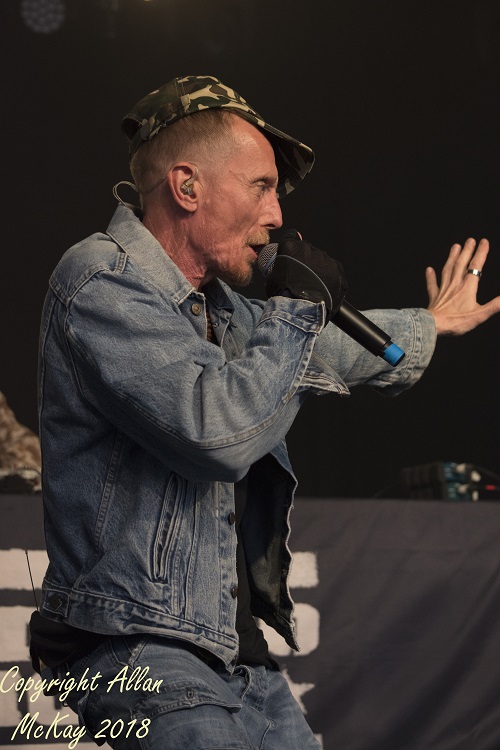
Last set on Friday night was UB40. I saw UB40 on their first national tour when they supported The Pretenders on tour across the UK in 1980. They were fired up, they wanted to succeed and they sounded amazing. Nearly forty years on, it’s a very different story; there are two UB40s touring and neither’s convincing. This version is pretty pedestrian, but they have one secret weapon – Brian Travers. I’m sure he wouldn’t claim to be the best sax player in the world, but he knows how to sell it:
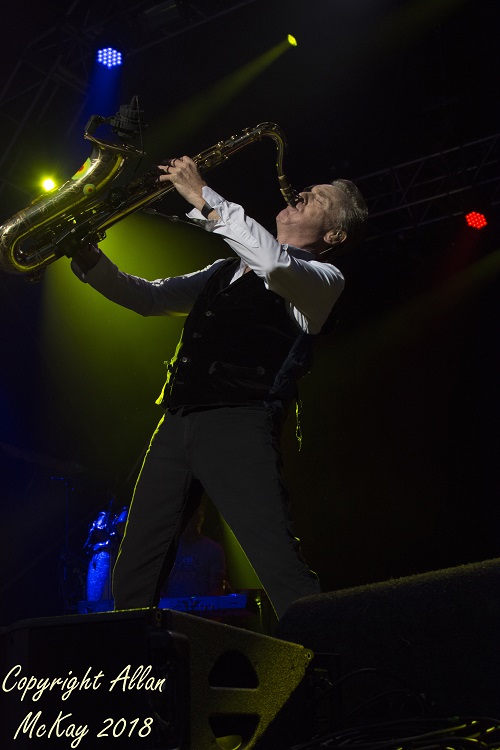
Saturday night was busy (although Alanis Morissette decided not to allow any press access for her set) and the Songbird Stage was the place to be. Obviously Mavis Staples was a do-not-miss, but PP Arnold was another. You would think she’d never been away; she sounded fabulous and looked like this:
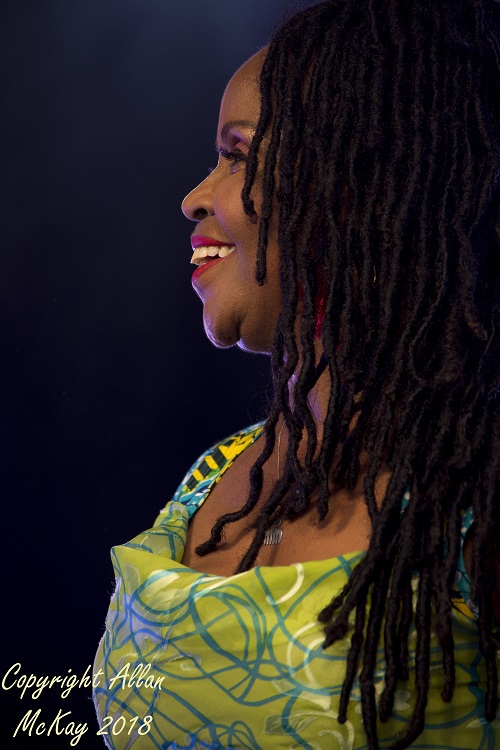
Sunday afternoon on the Pleasant Valley Stage; anyone for a bit of Deacon Blue? Definitely; I saw them a couple of times in the very early days and I loved them. It’s partly a Scottish thing, but it’s mainly a music thing. They have great songs and they have the experience to sell them on a festival stage. You never know, Ricky might do a bit of politics. Actually you do know, he will. Anyway, he’s looking pretty pumped these days:
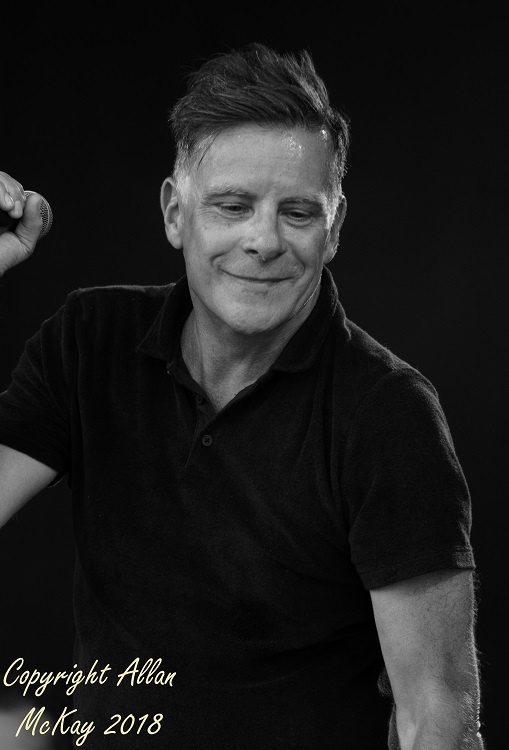
Sunday evening headliners – Squeeze. We go back a long way; I saw Squeeze for the first time at Dundee University Students’ Association; there were more people on stage than in the audience and it was still a great gig. I’ve photographed them on occasions forty years apart (I know, I don’t look that old) and I still love those Difford/Tilbrook songs. This time, it was Yolanda Charles that really caught my eye:
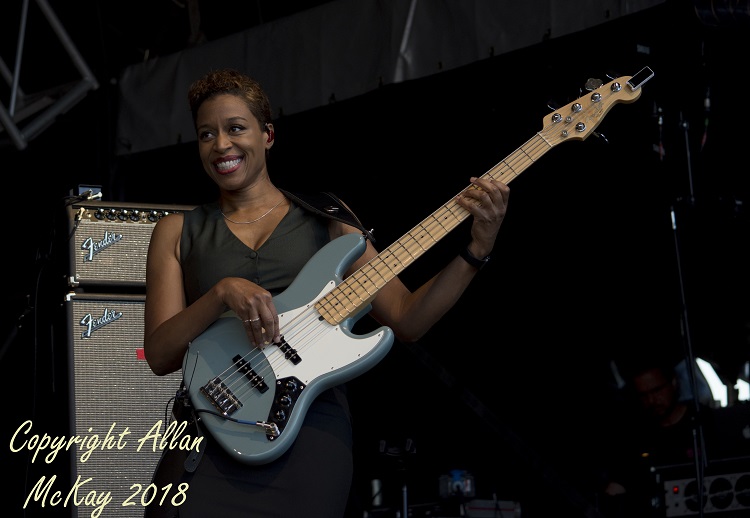
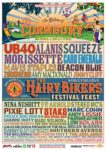 We try to do one festival a year here at Music Riot. Last year it was iconic Isle of Wight Festival; this year we’re staying a bit closer to home with a visit to Cornbury Festival in Oxfordshire. We took several factors into account before making the scientific decision to opt for Cornbury this year despite the stiff competition from the plethora of festivals across the UK, from the boutique to the behemoth. So, what do you think swayed us in the direction of Chipping Norton for this year’s summer outing?
We try to do one festival a year here at Music Riot. Last year it was iconic Isle of Wight Festival; this year we’re staying a bit closer to home with a visit to Cornbury Festival in Oxfordshire. We took several factors into account before making the scientific decision to opt for Cornbury this year despite the stiff competition from the plethora of festivals across the UK, from the boutique to the behemoth. So, what do you think swayed us in the direction of Chipping Norton for this year’s summer outing?
Well, let’s start with the headliners; UB40, Alanis Morissette and Squeeze. They’ve all enjoyed single chart success and critical acclaim and each of them has survived through several decades in the music business; four decades each in the case of Squeeze and UB40, and Squeeze are still knocking out great new tunes as if the last forty years never happened. Look a bit lower down the bill and you have all the reasons why anyone who loves music should be going to Cornbury.
There’s great music to appeal to all ages and tastes, from the reinvented P.P. Arnold and the evergreen Mavis Staples and Jimmy Cliff, through the nineties dance of Stereo MCs right up to the London Americana of the superb Danny and the Champions of the World. And, if that wasn’t enough, don’t forget that Cornbury has the poshest loos on the festival circuit; when you reach a certain age, that’s really important.
If all of that hasn’t convinced you, Caffe Nero have a stage at the event where you can get great coffee and see absolutely loads of upcoming talent. We’ve already heard many of the artists playing on the Caffe Nero stage over the last couple of years; you could spend the entire festival there and hear nothing but fabulous music. See you down the front.
Cornbury Festival takes place between Friday July 13 and Sunday July 15.
 By an interesting series of coincidences, I found myself backstage at a Southside Johnny & The Asbury Jukes gig at The Forum in Kentish Town pointing the trusty MusicRiot microphone in the direction of Gilson Lavis. If you have any interest at all in popular music, you must have heard of Gilson in one of his two musical careers; he’s a great and highly respected drummer but I wasn’t there to talk about his music; we don’t do the obvious stuff like that at MusicRiot. I was there to talk to Gilson about art. There’s a reference at the end to Johnny stealing my thunder; he voicebombed the interview about a third of the way in to talk to Gilson about how much he loved Squeeze.
By an interesting series of coincidences, I found myself backstage at a Southside Johnny & The Asbury Jukes gig at The Forum in Kentish Town pointing the trusty MusicRiot microphone in the direction of Gilson Lavis. If you have any interest at all in popular music, you must have heard of Gilson in one of his two musical careers; he’s a great and highly respected drummer but I wasn’t there to talk about his music; we don’t do the obvious stuff like that at MusicRiot. I was there to talk to Gilson about art. There’s a reference at the end to Johnny stealing my thunder; he voicebombed the interview about a third of the way in to talk to Gilson about how much he loved Squeeze.
Allan Hi Gilson. Some of us know you as the drummer in Jools Holland’s Rhythm and Blues Orchestra, The older ones know you as the drummer in Squeeze, but now you’ve got a new career as an artist, so how did that start?
Gilson Well, it started out of boredom really. I lead a pretty clean life these days; I don’t drink or any of the other stuff, thankfully and hanging about on the road or hanging about in hotel rooms, I’ve been doing it for about fifty years now, and it started to get a bit wearing, so I started to doodle and the doodles turned in to sketches and the sketches turned into paintings and now the paintings have turned into exhibitions. So it just sort of grew really and I’m in a very privileged position because with my position in the Rhythm and Blues Orchestra we get to play with some of the world’s best entertainers and performers and I see them close at hand and I try and paint them, and I think I can capture some of the real essence of the person.
Allan You had an art school background didn’t you? Did you continue to draw after you left art school and joined Squeeze?
Gilson No, I went straight into music, the driving force being sex; I wanted to pick up girls. It never really worked, but I got into the music business and I’m still doing that so the art was just put away really. I didn’t pick up a sketch pad or an easel or a paintbrush until about ten years ago, when I started again.
Allan Do you think you choose your subjects or do you think they choose you?
Gilson It’s a mixture of both really. As I said, I tend to sketch and paint people that I work with and sometimes I’ll get inspired by an image I see of somebody and I’ll paint from that, but really it’s working with these people that’s the driving force.
Allan You’re working mainly in acrylic on canvas aren’t you? Do you work in any other media?
Gilson Yeah, I do. I do ink sketches. That’s really what I do on the road, sketch in ink, but when I’m at home, I’ve got a large studio and my own gallery, so I paint at home and sketch on the road.
Allan In the creative process, do you have certain steps that you follow? I’m thinking of the preparation; I saw the Louis Armstrong sketch that you did and obviously you couldn’t do that from life so presumably you researched that online.
Gilson I do actually. A lot of the people I’ve painted or sketched, they’re too busy to sit for me; they’re not going to come round to my house and sit, so I do have to sketch from images. I try to take photographs when I’m working with them and sketch or paint from those, but it’s not always possible, because some of these people like Louis are no longer with us, I have to research them and I look for images that are inspiring and I tend to blend three or four images to get the look that I’m searching for, so it sort of grows.
Allan I’ve met quite a lot of musicians who have other artistic pursuits, painting, photography and so on. Do you think it’s a bit of a release valve?
Gilson I’m sure it is, it absolutely is. Though it’s a real privilege to work with the Rhythm and Blues Orchestra; it’s high profile and we play big venues, but it is quite a restrictive environment. I’m there to make Jools sound good, I’m there to make the big band work, I’m not really cutting loose on what I want to do and the painting really allows me to be creative.
Allan So the band becomes the day job and your creative outlet is the painting.
Gilson But it’s a very enjoyable day job, I’m in a very privileged position.
Allan I’m fascinated by the paintings and the way they reflect the personalities of the people you’ve portrayed and it struck me that they’re not hyper-realistic, but they’re a long way from caricature, aren’t they? The one that particularly struck me, and I wonder how people will react to it, was Keith Moon, because he has a really serene look in that portrait.
Gilson Well, thank you. There are many, many images of Keith being crazy, that’s what he’s famous for, but I really wanted that sort of innocence of the young lad before he went on that crazy journey. I think that’s what I was aiming for, that innocent, lost look, not even knowing what’s going on. What went on of course was craziness and death in the long run.
Allan That was what immediately grabbed me about that particular image, the innocence. I understand that you’ve got a book of some of your images out as well.
Gilson Do you mean the one with the drummer portraits?
Allan That’s the one.
Gilson It was released two months ago actually. It’s eighteen portraits of drummers that have influenced me with a short snippet of a quote by each of them. I was asked many times, who influenced me as a drummer and eventually I thought “I know, I’ve got a good idea, what I’ll do is I’ll paint my influences and put them in a book” and it seems to have worked really well, it’s popular and it’s selling quite well, I’m pleased to say. It’s called “Drummers” by Gilson Lavis.
Allan I understand there’s an exhibition coming up in New York as well.
Gilson There is, yeah, at the Salomon Arts Gallery in Tribeca and it opens on the fourteenth of September. I’m really excited about it; I’ve been fortunate enough to have a few exhibitions in Great Britain but this’ll be the first in New York and I’m really excited by it and a bit nervous, to be honest, because we’re all deeply insecure, us painters, we’re all waiting to be laughed at.
Allan I think photographers are exactly the same. Your career must have had so many highlights, is there anything that really stands out in your memory as a real high point?
Gilson Yes, there is. It was when I was fortunate enough to get the phone call to play drums with Smokey Robinson on Later and on rhythm was Eric Clapton, Jools Holland on piano and Dave Swift on bass and me on drums. In fact there’s a little story about that, we were there, Eric, myself and Jools were there ready to rehearse with Smokey and he was flying in from America and it got to his allotted rehearsal time and we got the message he was a bit tired so he’ll be here in a couple of hours. We all downed tools and waited and then he didn’t show up, he was still a bit tired, and the show started to be recorded and we still hadn’t seen him and I’m sitting behind the drum kit and Eric’s looking a bit sort of worried. We knew the song, everybody know Smokey’s songs. The band before us was playing and thirty seconds before they finished, Smokey Robinson walked out on to the set and I’ve never seen anybody look more like a star than he did; he glistened. His skin was beautiful, his hair was just perfect, he had an incredibly dapper suit; he walked out and I counted the song in and we played it and he was just magnificent and then he turned round and nodded at Eric, he ignored me completely but I don’t mind and off he went and that was it, that was my experience of Smokey Robinson. But it was fantastic, it was a real buzz to play with one of my heroes, and there have been many.
Allan Johnny actually stole my thunder earlier because I was going to say at the end, did you know that Johnny’s a big fan of Squeeze and Jeff Kazee’s also a huge Squeeze fan.
Gilson I didn’t know. I had no idea.
And with that, we had to clear out of the Jukes’ dressing room as the band prepared for the show, but not before Gilson presented Johnny with an ink portrait of Mr Lyon himself. A couple of hours later, Gilson joined The Jukes on stage, taking the drum stool for “Key to the Highway”. And here’s the Keith Moon portrait:
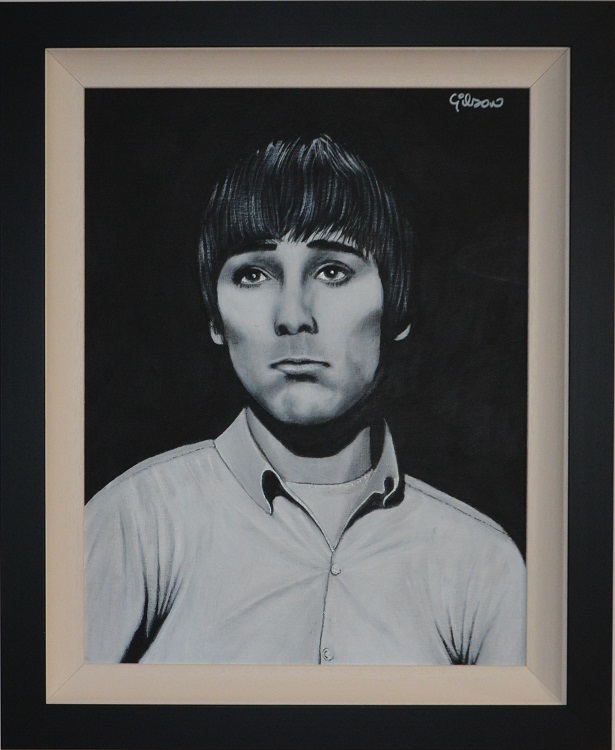
So how about five great gigs this year? Well, I’ve had plenty to choose from and I can’t say that I’ve seen a bad one, so it hasn’t been an easy choice to whittle it down to the top five (and no cheating this time either). These are all gigs that I walked away from feeling elated, feeling that I’d seen something special that I wanted to tell the world about. So I did, and here’s a reminder of how good these gigs were.
On a freezing February Friday night in Shoreditch, Rich Mix was a welcome respite from bars full of bankers and ‘exclusive’ lap-dancing joints. The venue is a social enterprise where the motivation isn’t purely profit and programming of events is always interesting. On this particular night, John Fairhurst, along with Pete Episcopo (bass) and Toby Murray (drums) played a raw and raucous set of blues focussing on the 2014 album “Saltwater”. Some of the album versions of the songs were fairly big production numbers but the live performance was strictly a power trio affair with John’s blistering guitar topping off the mixture. The journey back through Shoreditch didn’t seem quite so bad after a night of proper blues with electric guitars playing way up loud. You can see some photos from the gig here.
Mollie Marriott @The Half Moon
This one was firmly in the eagerly-anticipated category. Mollie’s been working quietly for some time putting together a great band for live and studio work featuring her Jim Stapley bandmates Izzy Chase-Phillmore, Sam Tanner and Johnson-Jay Medwik-Daley. After an interesting acoustic support set from her nephew, Mo Evans, Mollie’s full band made their first live appearance in a Half Moon packed with fans and a few well-known faces as well. It was obvious from the start that this isn’t just a bunch of hired hands; this is a bunch of really good mates as well. None of their playing is showy or attention-seeking; everything serves the songs and underpins Mollie’s phenomenal voice, and it all works perfectly. The audience were onside anyway, but Mollie and the band gave a great performance of material from the upcoming debut album and a couple of covers as well. Here are some photos of this one.
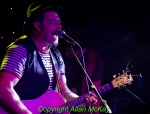 Mad Dog Mcrea and Sound of the Sirens @The Half Moon
Mad Dog Mcrea and Sound of the Sirens @The Half Moon
This was a very special gig. I’d been invited along to see Mad Dog Mcrea and I had no idea about the support on the night, Sound of the Sirens. It’s such a great feeling when you see an artist for the first time and you know instantly that they’re something special. And it’s not just me; apparently Chris Evans was quite impressed with them as well. Anyway, they played a storming set completely winning over the audience with their powerful songs, dynamics, and harmonies. If the night had stopped at that point, I would have been perfectly happy, but we still had Mad Dog Mcrea to come, with an energetic run through material from their album “Almost Home” plus a few old favourites and crowd pleasers. Two great bands with enough in common to appeal to the whole audience but with enough differences to create a very varied night. And there are some photos here.
 Squeeze and Dr John Cooper Clarke @Indigo2
Squeeze and Dr John Cooper Clarke @Indigo2
Another interesting double bill, this time with two very different artists, linked by the era which saw the start of their careers. John Cooper Clarke (now making the most of his honorary doctorate) has been doing poetry and comedy events for a few years but the tour with Squeeze put him back in front of big audiences filled with people who remembered him from the first time round. He throws more one-liners and gags into his routine now but a lot of the old favourite poems are still there, although some of them, particularly “Twat”, have evolved over time. On this night he was a barnstorming crowd-pleaser, building up the audience nicely for the headline act.
This year Squeeze had a new album to promote so the setlist was varied, to say the least, with material covering almost forty years from “Take Me I’m Yours” to new songs like “Cradle to the grave” with the usual smattering of different interpretations of Squeeze classics. What made this performance so special was the group of musicians (mainly Glenn Tilbrook’s Fluffers) now making up the rest of Squeeze who add upright bass, melodica and other esoteric instruments to the mix as well as adding rich vocal harmonies. Chris Difford and Glenn Tilbrook have never sounded better and what an incredible set of songs. Guess what, some photos here.
Graham Parker and Brinsley Schwarz & The Union Chapel
And finally. One of the greatest talents never to break through in the seventies and eighties, Graham Parker, who toured twice this year; once with The Rumour and once with Brinsley Schwarz. With a songbook which again covers almost forty years and a new album to promote as well, Graham Parker mixed up some established classics, some surprises and some new songs to delight an audience which might have been a little biased anyway. His voice is still remarkable and the songs are all strong enough to work in stripped-back arrangements. This wasn’t just a nostalgia thing; there were new songs to promote and they all sounded as good as anything he’s done before. He’s a remarkable man and it was a real pleasure to hear these songs in such a beautiful venue. How about a look at GP in the seventies and now?
It’s time to get the High Fives under way for 2015 and, in a break with tradition, I’m handing over the opening slot to one of our guests, Neil Sheasby, bass player and co-songwriter with one of The Riot Squad’s favourite bands, Stone Foundation. The band have had a great year with the release of their superb album “A Life Unlimited” (guest vocal from Graham Parker, no less), a Japanese tour and some high profile UK gigs. Neil’s observations on music are always interesting, so it’s a pleasure to let him have the first High Five this year.
 KAMASI WASHINGTON – “THE EPIC”
KAMASI WASHINGTON – “THE EPIC”
A record that pretty much defined my summer, for a few weeks I didn’t play much else. It is actually one of those albums that the more you listen to it, the more it will give you in return. It’s quite a sprawling, challenging recording set over three discs and clocking in at around three hours so it’s hard to digest all in one sitting but its depth, beauty and sheer ambition is unlike any other album I have heard in recent times. It could easily sit alongside the jazz heavyweights such as Coltrane’s output for impulse & Atlantic. Probably more accessible though. It has a timeless quality to it and an underlying spiritual vibe, funky too. I was lucky enough to catch his recent London gig and the playing was just on another level, astonishing stuff. Inspiring. He also led me to Kendrick Lamar’s “To Pimp a Butterfly” album (Kamasi plays on it) which is a great modern hip hop record again pushing & re-defining the boundaries of that particular genre.
I think 2015 has been a strong year for new releases and new music in general, it’s been encouraging.I’ve really enjoyed new albums from artists I hadn’t previously heard of like Ryley Walker whose “Primrose Green” album evokes traces of John Martyn & Tim Buckley; also the Julia Holter record is an interesting listen but I must admit the real surprises of the year have lain with the rejuvenation of established arists that have made really unexpected returns to former glories. New Order’s “Music Complete” album was a real eye opener, easily their best since 1989’s Technique. It’s a real triumph; Peter Hook free too! They should be proud of such a complete piece of work after all these years, it was a bona fide pleasant surprise to my ears, I’d about written them off.
Also this year there’s been great new albums from Joe Jackson (“Fast Forward) and Squeeze (“Cradle to the Grave”) that are fit to stand alongside any of their previous highlights.
This is a film about the relatively short life of British Jazz genius Tubby Hayes. It was made by two good friends of mine, Mark Baxter & Lee Cogswell and it’s a fascinating profile and made with much affection for its subject, narrated by Martin Freeman and it includes commentary & interviews with Sir Peter Blake, Spike Wells, Robert Elms, Simon Spillett and Ed Piller amongst others. I’ve known Mark for several years now and from day one he always had a burning desire to create a fitting documentary as a testament to Tubby’s life & music, he’s more than succeeded, I’m so pleased for him & Lee. It’s a fantastic little film and one that had me running for the records again.
Me and a mate recently attended the London launch party for its DVD release and on the train home it had us talking passionately about London & the Soho jazz scenes through the years, the clothes and the clubs, the DJ’s, bands, singers etc.That’s the tell-tale sign that “A Man in a Hurry” film had served its purpose all right.
Released earlier this year The RCA Victor and T-Neck albums all housed together in a 22 CD box set. It spans the Isleys career from 1959 up to 1983 taking in all those classic mid 70’s albums as well as a previously unreleased live album recorded at Bearsville Sound Studios. It’s an absolute beauty and really highlights the often overlooked genius of The Isley Brothers. Ronald, Ernie and Rudolph began with Doo-wop roots and evolved marvellously through classic Soul, Funk and even disco
It’s an incredible collection, once I get immersed in it, I’m in there for days on end. Brilliant stuff.
 YOU KNOW MY NAME: THE LOVERS, THE DREAMERS AND BOBBY SCOTT
YOU KNOW MY NAME: THE LOVERS, THE DREAMERS AND BOBBY SCOTT
A compelling & fascinating read by one of my favourite writers, Kevin Pearce. It’s actually the first book I have ever read from start to finish on my phone, it was my companion whilst on holiday this summer. Not many will be familiar with the name of Bobby Scott but it’s probably safe to say that you would have certainly heard his work.
Bobby composed, arranged, sang, produced and performed with countless artists including Marvin Gaye, Bobby Darin, Timi Yuro, Aretha Franklin, Chet Baker, Quincy Jones, Roland Kirk, Deodato, Stan Getz, Astrud Gilberto and a cast of thousands more. Bobby Scott songs include “A Taste of Honey”, recorded by the Beatles, and the epic “He ain’t Heavy, He’s my Brother” which The Hollies struck gold with (also check Donny Hathaway’s miraculous version) The only downer to reading this book is that it will seriously have you running back and forth to You Tube checking out song after song and of course in my case, being a hopeless music junkie, I ended up spending a small fortune on chasing up some of these spectacular sounds for my ever expanding collection.
I also read great autobiographies from Robert Wyatt, Bernard Sumner, Nile Rodgers, and somewhat refreshingly the Italian footballer Pirlo. I was a tad disappointed with the Grace Jones book, thought it would be more telling I think, then again Paul Morley was involved so no surprise I was underwhelmed.
I’m just about to begin Elvis Costello’s “Unfaithful music and Disappearing Ink”; looking forward to it…..
 There’s only one band I’ve seen more often than I’ve seen Squeeze (answers in the comments box if you think you know who that is) and one of the interesting things they have in common is that they don’t have a precious attitude about the recorded versions of their songs. Chris Difford and Glenn Tilbrook have always been willing to try new arrangements; I must have heard half a dozen different versions of “Goodbye Girl” over the years and I never heard one I didn’t like. On this tour, Squeeze is basically Glenn’s band The Fluffers plus Melvin Duffy and they all play on the new album “Cradle to the Grave”; each member brings their own particular contribution to the overall sound. Simon Hanson is the archetypal drummer, full of energy and charisma, while his rhythm section partner, Lucy Shaw, dominates the right side of the stage with electric bass, double bass, ukulele and backing vocals. Stephen Large adds keyboards (including accordion and melodica) and Melvin Duffy plays just about anything with strings, including pedal steel and Weissenborn guitar. They’re all wonderful players (and singers) and add layer upon layer of instruments and vocals to the live sound.
There’s only one band I’ve seen more often than I’ve seen Squeeze (answers in the comments box if you think you know who that is) and one of the interesting things they have in common is that they don’t have a precious attitude about the recorded versions of their songs. Chris Difford and Glenn Tilbrook have always been willing to try new arrangements; I must have heard half a dozen different versions of “Goodbye Girl” over the years and I never heard one I didn’t like. On this tour, Squeeze is basically Glenn’s band The Fluffers plus Melvin Duffy and they all play on the new album “Cradle to the Grave”; each member brings their own particular contribution to the overall sound. Simon Hanson is the archetypal drummer, full of energy and charisma, while his rhythm section partner, Lucy Shaw, dominates the right side of the stage with electric bass, double bass, ukulele and backing vocals. Stephen Large adds keyboards (including accordion and melodica) and Melvin Duffy plays just about anything with strings, including pedal steel and Weissenborn guitar. They’re all wonderful players (and singers) and add layer upon layer of instruments and vocals to the live sound.
But what about Dr John Cooper Clarke as support? Well, he’s promoting his new album “Anthologia” and the idea of supporting a band’s nothing new; he did it hundreds of times during the punk era. Nearly forty years on, it still works; there are no musical rivalries between bands to worry about and JCC’s mix of manic recital and laconic links and gags is a perfect way to warm up for the Squeeze hometown gig. The old favourites are there, “Beasley Street”, “Evidently Chickentown” and “Twat” (including verses which weren’t in the original) as well as newer material like “Beasley Boulevard” dealing with the gentrification of inner cities. There’s more chat between poems than in the past and it’s usually hilarious, offering a novel and skewed perspective on everyday life. There’s the occasional stumble in the motormouth delivery, but that’s forgivable and he leaves the audience well and truly ready for the main event.
After an intro from Danny Baker, the set begins with Glenn Tilbrook wandering on stage while playing some intro music which morphs into “Hourglass”, with one of the catchiest of many catchy Squeeze hooks. As you might expect from two people with the experience of Glenn Tilbrook and Chris Difford, the set is perfectly paced, seamlessly weaving three-quarters of the new album in with the old classics and a few surprises. There’s a double hit of nostalgia on this tour as well, because the “Cradle to the Grave” material is set in the early seventies and a few of the songs are already familiar to the audience.
The quality of the band and the range of instruments they play allows for an incredibly varied set musically and visually; everyone sings and they’re able to vary the dynamics of the set by having the entire band along the front of the stage (and even into the audience) a couple of times for a more intimate acoustic feel. The performances are all absolutely spot on but there’s a hugely contagious enthusiasm at play as well. Everyone on stage is having a great time, and who wouldn’t, working your way through some of the finest pop songs ever written. There’s even a couple of non-originals too; The Tom T Hall classic “Harper Valley PTA” gets an energetic run through while Chris takes a lead vocal on a laconic version of Tom Waits’ “I Don’t Wanna Grow Up”. As for the hits, “Hourglass”, “Is That Love?”, “Another Nail in my Heart”, “Tempted”, “Pulling Mussels from the Shell” and “Up the Junction” are all fairly close to the originals while an intimate hits section in the middle of the set has a zydeco version of “Slap and Tickle”, an acoustic version of “Goodbye Girl” with congas, and stripped back acoustic version of “Black Coffee In Bed”.
Hearing those catchy, inventive melodies and clever but under-stated lyrics again is a reminder of the importance of this band to a whole generation in the UK, evoking a time when life wasn’t necessarily better but it was a lot simpler and the soundtrack was superb. You still have five chances to see them on the UK leg of their tour and “Cradle to the Grave” is available now as well. This might just be the time to re-acquaint yourself with two of British pop’s finest writers.
And here’s a coincidence; the only band that I’ve seen more times than Squeeze has two members who are big fans of Chris and Glenn. Who could they be?


